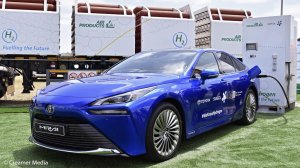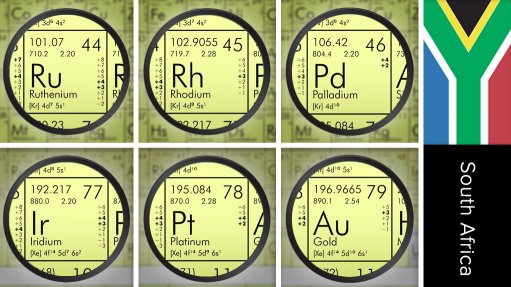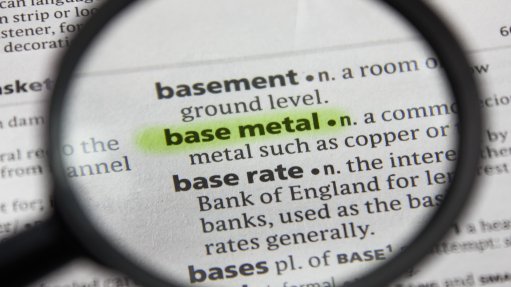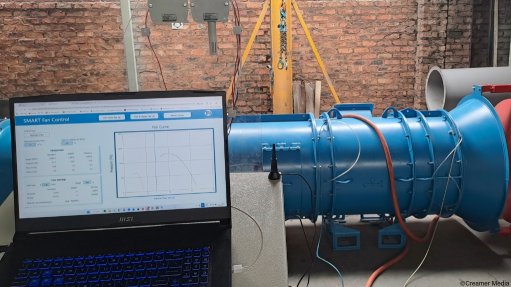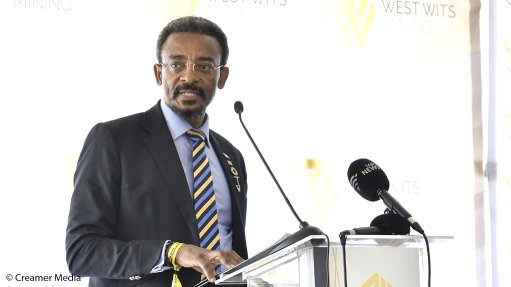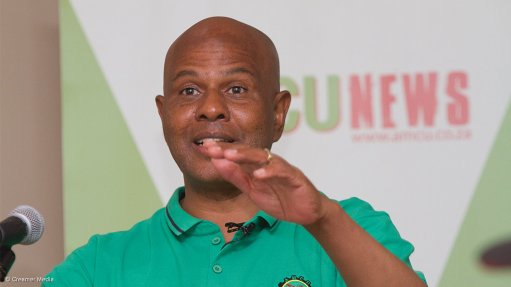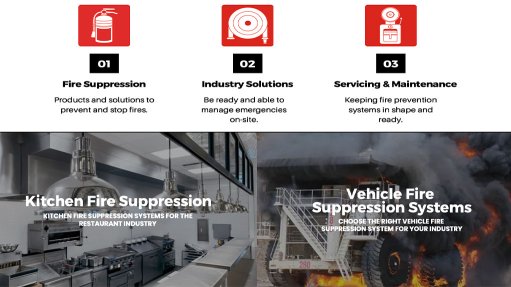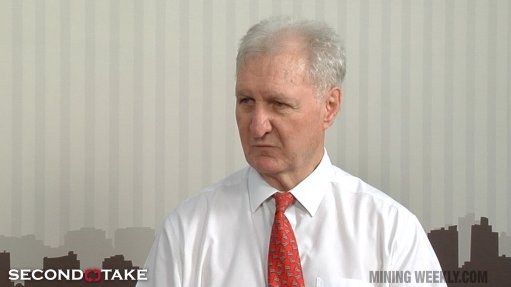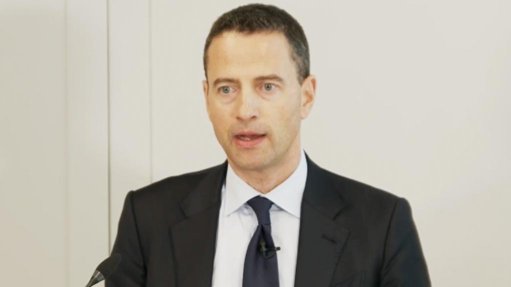Fuel cell electric vehicle demonstration seen as catalyst for nascent green hydrogen economy

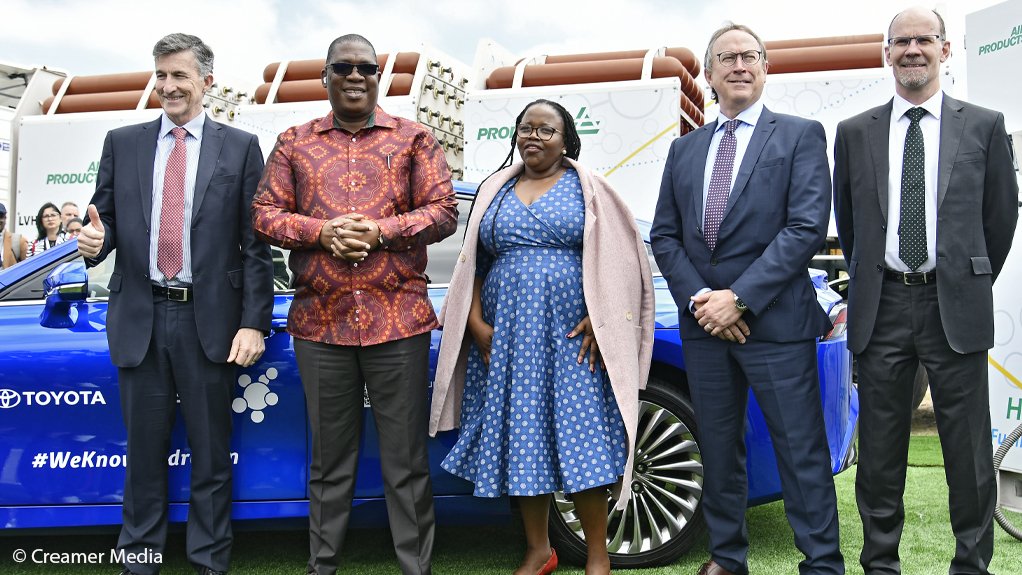
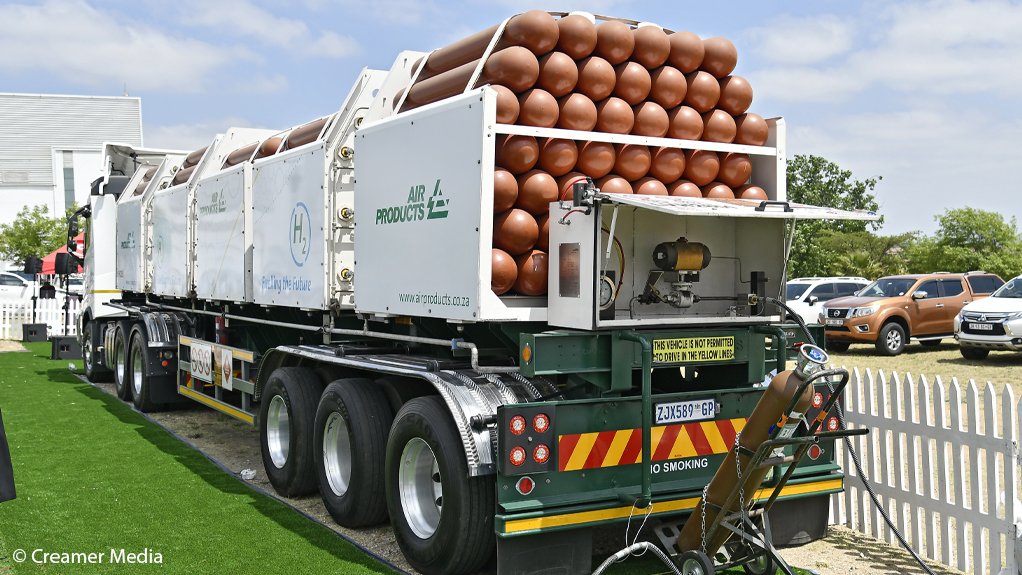
Sasol’s Fleetwood Grobler, Toyota South Africa Motors’ Andrew Kirby and Air Products South Africa’s Rob Richardson explain the significance of the using Toyota' Mirai fuel cell electric vehicle to showcase Sasol’s green hydrogen production and Air Products’ hydrogen dispensing technology at the Smart Mobility Africa Summit in Gauteng. Videographer: Shadwyn Dickinson. Editing: Nicholas Boyd. Recorded 2.10.2023
Toyota's Andrew Kirby, Gauteng Premier Panyaza Lesufi, Gauteng Transport MEC Kedibone Diale-Tlabela, Sasol's Fleetwood Grobler and Air Products MD Robert Richardson at proof of concept launch at Smarter Mobility Summit
Photo by Creamer Media's Donna Slater
Air Products tube trailer carrying hydrogen
Photo by Creamer Media's Donna Slater
In a milestone for South Africa’s nascent green hydrogen economy, three large corporates have teamed up to showcase the potential of using domestically produced hydrogen as a zero-emission transportation alternative.
During a demonstration in Gauteng, a second-generation Toyota Mirai fuel cell electric vehicle (FCEV) was refuelled with hydrogen produced by Sasol in Sasolburg, in the Free State. The hydrogen was transported by truck in an Air Products tube trailer, and the vehicle was refuelled on site using the US multinational’s mobile hydrogen dispensing technology.
Toyota South Africa Motors (TSAM) CEO Andrew Kirby then drove the vehicle, which contains a platinum-based fuel cell, around a test track set up at the Smart Mobility Africa Summit, taking place at the Gallagher Convention Centre, with Gauteng Premier Panyaza Lesufi in the passenger seat.
Sasol CEO Fleetwood Grobler described it as a “beautiful application of hydrogen fuel-cell technology”.
He stressed, however, that all three partners were focusing primarily on using green hydrogen in hard-to abate and hard-to-electrify sectors, such as long-distance and mining transportation, as well as aviation green steel, with the passenger vehicle demonstration seen as a catalytic proof-of-concept initiative.
Such an approach appears to be in line with South Africa’s yet-to-be-published Green Hydrogen Commercialisation Strategy, which will prioritise exports to lock in green hydrogen-linked subsidies from developed economies, alongside domestic applications such as off-road mining vehicles, long-haul trucking, steel, chemicals, fertilisers and sustainable aviation fuels (SAFs).
This point was underlined by Air Products South Africa MD Rob Richardson who described the FCEV demonstration as an awareness-raising exercise, while also emphasising the potential for green hydrogen in heavy-haul trucking, owing to its energy density.
The Toyota Mirai, for instance, required only 6.8 kg of hydrogen to travel 650 km and hydrogen’s energy density was, thus, seen as an advantage for trucks as the fuel would allow for large payloads to be transported over long distances without affecting power or performance.
“Today is an important stepping stone towards realising the ambitious goal of developing an on-road hydrogen mobility ecosystem,” Grobler reported.
Sasol has already indicated that it is pursuing partnerships to develop hydrogen fuelling infrastructure on key corridors, including the high-density N3, as part of a three-pronged green hydrogen strategy. Its other two focus areas include manufacturing SAFs, including establishing OR Tambo as a SAF hub, and green steel opportunities in the Vaal Triangle.
The JSE-listed group produced its first green hydrogen in Sasolburg in June, using a repurposed 60 MW electrolyser and electricity produced at a 3 MW solar farm. The electrolyser uses renewable electricity to split water into oxygen and hydrogen.
The electrolysers are currently producing at a daily rate of 150 kg, but Sasol energy business VP Priscillah Mabelane reports that daily output will rise to 3 500 t during 2024 when electricity is wheeled to Sasolburg from the 69 MW Msenge Emoyeni Wind Farm, in the Eastern Cape.
Sasol is already a significant producer of grey hydrogen from coal and is keen to progressively shift its feedstock from coal to gas and green hydrogen to meet its commitment to reduce greenhouse-gas emissions by 30% by 2030.
The group’s shift to green hydrogen will depend on access to cheap renewable electricity, which South Africa’s solar, wind and land endowments make feasible, as well as a decline in the cost of electrolysers so that green hydrogen can be produced at below $2/kg – currently costs are said to be closer to $5/kg.
Air Products, meanwhile, has six decades of experience in hydrogen, including supplying hydrogen to NASA for the Apollo space programme, and operates the largest hydrogen pipeline network in South Africa.
Richardson said the group is keen to play a leading role in establishing a sustainable domestic hydrogen ecosystem, noting that the company has more than 250 hydrogen fuelling sites in 20 countries and holds 50 patents for hydrogen fuelling.
“Air Products is involved not only in fuelling cars, trucks and buses, but also submarines, ships, train locomotives, power generating systems, forklifts, and materials handling equipment,” Richardson adds.
While Kirby acknowledged that FCEV’s such as the Mirai were unlikely to secure significant market share domestically, he too expressed optimism about the potential for niche applications, beyond trucking.
He noted, for instance, that there was a 120-strong Mirai taxi fleet operating in Munich, Germany, and that TSAM’s plant in KwaZulu-Natal had collaborated with Toyota in the UK to produce a Hilux FCEV bakkie prototype.
The prototype was assembled by Toyota UK, but the basic vehicles were built in Prospecton and sent to England for fitment of the hydrogen fuel cell powertrain.
“Ideally, we need businesses and fleets to commit up front to buy hydrogen FCEVs and substantial quantities of hydrogen to make the necessary infrastructure viable,” Kirby said.
Besides investment in production and infrastructure, Richardson argued that supportive policy and regulation would be crucial if green hydrogen were to play a significant future role in South Africa’s transport sector.
Article Enquiry
Email Article
Save Article
Feedback
To advertise email advertising@creamermedia.co.za or click here
Announcements
What's On
Subscribe to improve your user experience...
Option 1 (equivalent of R125 a month):
Receive a weekly copy of Creamer Media's Engineering News & Mining Weekly magazine
(print copy for those in South Africa and e-magazine for those outside of South Africa)
Receive daily email newsletters
Access to full search results
Access archive of magazine back copies
Access to Projects in Progress
Access to ONE Research Report of your choice in PDF format
Option 2 (equivalent of R375 a month):
All benefits from Option 1
PLUS
Access to Creamer Media's Research Channel Africa for ALL Research Reports, in PDF format, on various industrial and mining sectors
including Electricity; Water; Energy Transition; Hydrogen; Roads, Rail and Ports; Coal; Gold; Platinum; Battery Metals; etc.
Already a subscriber?
Forgotten your password?
Receive weekly copy of Creamer Media's Engineering News & Mining Weekly magazine (print copy for those in South Africa and e-magazine for those outside of South Africa)
➕
Recieve daily email newsletters
➕
Access to full search results
➕
Access archive of magazine back copies
➕
Access to Projects in Progress
➕
Access to ONE Research Report of your choice in PDF format
RESEARCH CHANNEL AFRICA
R4500 (equivalent of R375 a month)
SUBSCRIBEAll benefits from Option 1
➕
Access to Creamer Media's Research Channel Africa for ALL Research Reports on various industrial and mining sectors, in PDF format, including on:
Electricity
➕
Water
➕
Energy Transition
➕
Hydrogen
➕
Roads, Rail and Ports
➕
Coal
➕
Gold
➕
Platinum
➕
Battery Metals
➕
etc.
Receive all benefits from Option 1 or Option 2 delivered to numerous people at your company
➕
Multiple User names and Passwords for simultaneous log-ins
➕
Intranet integration access to all in your organisation


